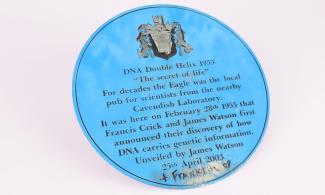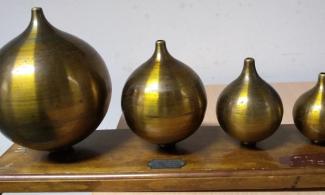Welcome to the Whipple Museum of the History of Science.
Discover a vast array of scientific instruments dating from the Middle Ages to the present day. From microscopes and telescopes to pocket calculators and slide rules, find out more about the tools that scientists have used to understand the world around us.
Collection Highlights
- Papier-mâché anatomical model of a human, c. 1890 - When Dr. Louis Auzoux created these dissectible anatomical models with a revolutionary technique, he expanded the possibilities for learning about the human body.
- The Grand Orrery, c. 1750 - This ornate model of the solar system, as it was then known, used a complex clockwork mechanism to demonstrate the relative orbits of the planets around the sun.
- Planispheric Astrolabe, 14th century - One of the earliest known English astrolabes. Astrolabes have been used by astronomers and navigators for almost two thousand years to measure the position of celestial bodies.
- Charles Darwin’s microscope, c.1846 - Darwin purchased this impressive microscope to process samples he collected on the HMS Beagle. He used the microscope to focus on his “beloved cirripedia” – barnacles – the study of which informed his theories on species variation.
- Ingeborg Brun’s Mars Globe, c. 1930 - Brun created her globes using Percival Lowell’s popular maps of Mars. Lowell claimed he could see evidence of life on Mars, in the form of canals. Brun was inspired by the fair and cooperative communities Lowell’s observations suggested.
Free entry
Open on the third Saturday of every month. Please check the Whipple Museum website.
Contact Us
Website: whipplemuseum.cam.ac.uk
Call: 01223 330906
Email: enquiries@whipplemuseum.cam.ac.uk
Social Media:
Facebook
X/Twitter
Instagram
Research Enquiries and Image Permissions
For information about consulting the collection for research purposes, see the Museum's research profile.
For image permissions, please contact the Museum directly: enquiries@whipplemuseum.cam.ac.uk
Travel
The University's museums and Garden are within walking distance of each other. If travelling by car, we recommend using Park and Ride services.
Opening hours
Getting here
52.203351, 0.11875420000001
Accessibility
If you have special access requirements, please contact the Museum in advance of your visit in order to make your experience as smooth as possible: hps-whipple-museum@lists.cam.ac.uk
For full accessibility information, please visit the Whipple Museum website.
A visual story: Whipple Museum of the History of Science
This visual guide will help your child know what to expect and ease the anxiety which often accompanies a visit to somewhere new and unfamiliar. Download the Whipple Museum Visual Story to help plan your visit
Step free access
Step free access is available. Enter the Museum at the accessible entrance via the New Museums Site entrance on Downing Street. There are lifts to all floors and step free access to all areas of the galleries.
Visibility impairments
The Museum is well-lit throughout. Handling objects are situated in the boxes in the Learning Gallery and throughout the Victorian Parlour.
Hearing impairments
There is no hearing loop.
Disabled parking
There is disabled parking on Free School Lane, directly outside the museum.
Changing Places Toilet
The closest Changing Places toilet is located in the Grand Arcade car park. Locate more Changing Places toilets in Cambridge.
Additional Whipple Museum Access Information
Visit the AccessAble website





